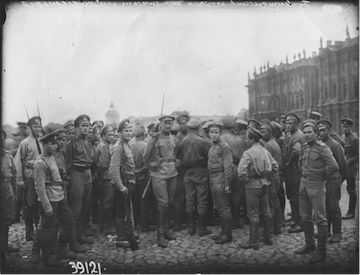This section covers the period of Lenin's revolution, from July 1917 to March 1918. We will be explaining the collapse of the Provisional Government and asking what it was that mobilized the masses behind the call for Soviet Power in October 1917? How far did Lenin's call for an uprising meet the mood of the masses? How many people took part in October? Was it a social revolution or a coup d'état? How did the Bolsheviks establish their dictatorship? what compromises did they make to secure peace. You will find some answers to these questions in this section, which contains extracts from my books, photographs and videos, and a reading list. Register here to get information on accessing more materials including my responses to exam questions on these themes.

Last Defenders of the Winter Palace, October 1917
After the July Crisis Kerensky was hailed as the man to reunite the country and halt the drift towards civil war. He was the only major politician who had a base of popular support yet who was also broadly acceptable to the military leaders and the bourgeoisie. Read more...
Lenin called for an armed insurrection. Writing from Finland, where he had fled to avoid arrest following the failed uprising in July he told the Bolshevik leaders that they 'can and must take state power into their own hands.' Read more...
Few historical events have been more profoundly distorted by myth than those of 25 October 1917. Read more...
The effect of their action was to give a Soviet stamp of approval to a Bolshevik dictatorship. Read more...
Historians have always been sharply divided on this question. Read more...
Few people thought the Bolsheviks could hold onto power for long. The Party had a tenuous hold on the capital, where the civil service, post and telegraph, and banks went on strike against their seizure of power, but very weak support in the provinces. Read more...
The opposition parties pinned their hopes on the Constituent Assembly. Read more...
There was no popular reaction against the dissolution of the assembly. The peasantry, who had supported the SRs, saw the Constituent Assembly as a symbol of 'the revolution' but it was only a distant thing in the city, whereas they had their own village Soviets which carried out the revolution on the land. Read more...
General Denikin gives a good idea of what it meant to be a 'burzhooi' after October 1917. Read more...
The Decree on Peace was an expression of hope, not a statement of fact. The Bolsheviks used it as propaganda to fan the flames of revolution in the West. The belief in the imminence of a world revolution was central to Bolshevik thinking. Read more...
Here are some exam-like questions. Read more...
A recording of a lecture/class about these themes using primary documents. Read more...
A list of further reading. Read more...

